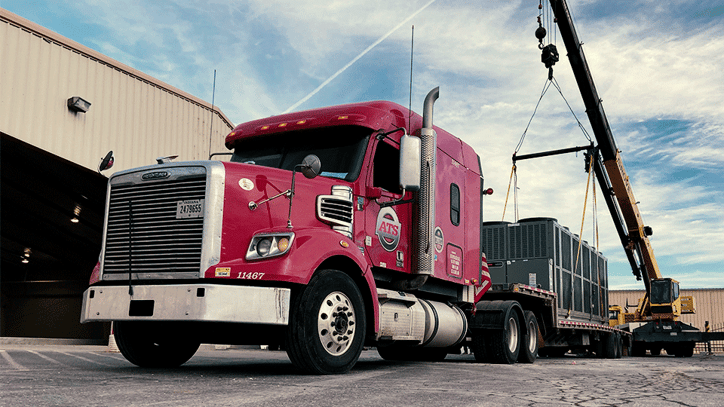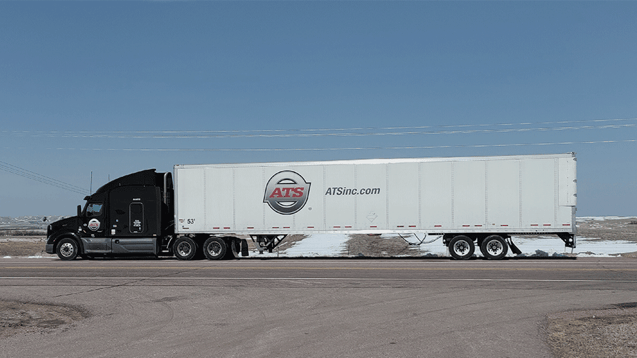
In November 2021, the U.S.’ manufacturing output index — a segment of the Industrial Production Index (used to gauge the real economic production of national industries like oil & gas, mining, etc) —- increased to its highest level in over three years.
Suffice it to say, American economic activities are booming and manufacturing companies shoulder much of this burden.
For you — as a core piece of your company’s supply chain — this increasing demand for production produces a continual cry for efficiency that often leaves you feeling overwhelmed — especially when it's time to get your cargo moving.
With so many things on your plate each day, it’s understandable if you try to keep your interactions with the transportation industry to a minimum.
Here at Anderson Trucking Service (ATS), we know that the transportation of your freight — the cargo essential to your business — is a debit on your balance sheet; an expense to weather.
That said, moving your products from A to B without the right understandings, expectations, providers and tools, can quickly get out of hand, breaking the bank and your commitments to customers.
Learning this industry, the things that influence pricing, the things that make it tick and the tactics for managing your supply chain, isn’t easy. But we’re here to show you how.
Below, you’ll find an in-depth guide to the top six tactics for increasing your efficiencies and, as a result, decreasing the overall dollars you spend moving your freight.
Six tactics you should consider employing in your manufacturing transportation processes are:
- Prioritize real-time visibility on every load.
- Ensure you have access to flexible capacity that matches your needs.
- Identify opportunities to round-trip your carriers.
- Consolidate smaller orders into full-truckload quantities.
- Add flexibility to your dock scheduling practices.
- Consider utilizing both live-loading and drop trailer programs.
Tactic #1: Prioritize Real-Time Visibility On Every Load

As you know, successfully manufacturing something, no matter what that product is, takes planning. Research and development need to be done, raw materials need to be congregated, workers need to be managed and, in the end, customers need to be acquired.
This same amount of care should be given to your transportation processes as well.
Luckily, when it comes to managing your inbound and outbound freight shipments, there’s no shortage of tools to help you do so.
As the digital age continues to march on and companies worldwide strive to hasten production, technological innovation has breached the transportation industry’s shores.
As a result, holding to the mantra of “work smarter not harder” has never been easier for manufacturing businesses like yours. And, with the right providers in your corner, overseeing your freight’s journey shouldn’t be an issue.
Load tracking capabilities — provided via the electronic logging devices located in each semi-tractor and various mobile applications — have become increasingly common in recent years. These technologies help shippers break down the barriers that traditionally separated them from visibly monitoring their freight shipments.
Make sure to fill your transportation network with companies that offer 24/7 load tracking capabilities.
The investment it takes to offer this convenience — however minor it may be today — signifies a commitment to customer satisfaction and service. Transportation providers that make these things a priority should be the preferred providers of your business.
Tactic #2: Ensure You Have Access to Flexible Capacity That Matches Your Needs
Often, manufacturing businesses, like yours, are cyclical by nature. Influenced by changes to buyer patterns and seasonal shifts, these companies see their demand for transportation capacity swell and fall — somewhat predictably.
If this sounds familiar, then you understand how impactful flexibility can be when managing your supply chain. Acquiring elastic transportation capacity to match your changing needs starts with the providers you choose.
Make sure to build your network based on your changing needs. Find asset carriers and freight brokers that are capable of changing with you. Transportation is a fast-moving industry brimming with intricacies and adjustments.
By understanding the ebbs and flows of your manufacturing cycles, you’ll be able to match the overarching needs of your business to the strengths of your network.
Here’s what I mean:
The greatest providers recognize the changing needs of their customers and have systems in place for meeting these demands.
That said, every transportation provider has established areas of strength.
These are areas, regions and/or locations in which this company is strongest. In these locations — bracketed by well-rounded infrastructure, a customer base and extensive trucker domicile — they can offer competitive pricing and reliable service.
Even in the busiest of times and on the shortest of notice, trucking companies — which must uphold their commitment to keeping drivers loaded and moving — can help their customers secure capacity within these areas.
As a shipper’s requirements edge away from these regions, however, a carrier’s ability and willingness to move shipments falter. Without the established infrastructure their strong areas offer, many carriers simply can’t meet capacity demands or price their services as competitively as others.
For this reason, when building your manufacturing transportation network, it’s important that you verify each prospective provider’s area(s) of strength and choose accordingly.
A network filled with companies that have different strengths and weaknesses will help you cover your changing transportation needs — no matter how demanding they become.
Tactic #3: Identify Opportunites to Round-Trip Your Carriers

For trucking companies, getting a high level of productivity from their assets is important. Unlike third-party providers — which don’t own or operate any of the transportation equipment used to move a load — asset carriers need to vigilantly monitor and manage the movement of their drivers.
Performing this duty, necessitated by the heightened cost structure these companies boast, is usually easier said than done. You see, professional truck drivers must adhere to a specific set of rules and regulations dictating the time they’re allowed to be actively “on-duty” within a 24 hour period.
As it currently sits, these hours of service guidelines, as they’re known, limit each trucker’s service hours to 14 per day. This on-duty clock starts as soon as a driver starts their truck in the morning and ends exactly 14 hours later (leaving 11 hours for driving and the remainder dedicated to break periods).
Related: What are the Hours of Service (HOS) For Truck Drivers?
With these regulations in mind, asset companies need to ensure two things:
- That every driver in their fleet is given ample money-making opportunities (especially in today’s transportation market).
- That no truck in their fleet is left idling for extended periods without a load under them.
As you may suspect, trucking companies highly value shippers that can help them achieve these ends.
Many manufacturing companies, like yours, are uniquely capable of doing just that.
Due to the complexity of many manufacturing supply chains — which typically require more transportation activities than others — “round-tripping” carriers is an option.
Give your carriers the option of hauling a load out of their initial endpoint.
Whether it’s a series of milk-run raw material pick ups headed toward your manufacturing facility or a truckload of components they can use as a backhaul, giving your carriers a round-trip commitment can benefit your relationship and the rate your receive.
Tactic #4: Consolidate Smaller Orders Into Full-Truckload Shipments
Manufacturing supply chains are complex. With multiple orders to fill, projects to finish and customer commitments to meet, manufacturing professionals have a lot on their plates.
That said, sometimes manufacturing supply chains are complicated by the people running them.
You see, although it’s not uncommon for manufacturing businesses to have one-off customers (customers that order a single product/shipment and never do again), the majority of the time repeat transactions/orders occur.
In these instances, consolidation and coordination are crucial to the fulfillment of these commitments in a cost-effective manner.
Instead of sending multiple less-than-truckload (LTL) or partial-truckload (PTL) quantities of cargo to a single receiver over course of a week, consolidating these orders would actually be more cost-effective and almost certainly result in better service and potentially fewer claims. Or perhaps you can plan multi-stop truckloads, where a single truck might deliver to 2 or 3 receivers along a single route.
If possible — with permission of your consignee(s) — arranging for the full-truckload transportation of what would otherwise require multiple smaller shipments will save you the dollars you’d spend securing multiple solutions.
Beyond this, with a dedicated truck under your employ, you’ll find predicting transit times and freight arrival times to be far easier.
Sure running this correctly will take a bit more planning, communication with your customers and enough space to store congregated goods (a great excuse to begin a drop-trailer program) but the cost savings you’ll receive will be well worth it.
Tactic #5: Add Flexibility To Your Dock Scheduling Practices
Expanding your trailer types options isn't the only way to cut down your transportation costs in the manufacturing industry. Adding flexibility to your pick-up and delivery windows will also do wonders for your bottom line.
The effectiveness of this tactic is, once again, tied to a carrier’s ever-present desire to make the most of their HOS. Rigid pick-up and drop-off appointments aren’t always easy for truckers, especially with other commitments to plan for.
And, oftentimes, if your freight has difficult demands to meet finding a solution for it can get expensive.
To avoid these issues, consider adding some flexibility to your scheduling windows.
This could mean:
- Instead of planting firmly on an 9 a.m. pick-up appointment, try a timeframe of 8 a.m. to 11 a.m. instead. (The bigger the window, the better likelihood your preferred carrier can match an available truck to your shipment).
- Adjust your required delivery time frame from 3 p.m. sharp to a wider window of 10 a.m. to 3 p.m.
- Instead of requesting a driver pick up your load on a Friday at 3 p.m. and sit on it until Monday at noon, adjust your schedule to allow for a same-day pick and drop.
- Consider asking your carriers what drop-off times would work best for them and see if your schedule could match. Most recently, shippers have used scheduling technologies to help them field carrier input. With these systems in place, carriers are given a variety of times to consider and have the option to select the one that works best for them.

Although adding a bit of flexibility to your pick-up and drop-off requirements will make it easier for trucking companies to match your needs, there’s one other adjustment you’ll want to consider.
To save money on your freight rates, try to avoid:
- Strict morning pick-up requirements.
- Strict afternoon delivery requirements.
In the interest of making the most of their drivers’ hours, trucking companies like to schedule deliveries in the morning and pick-ups in the afternoon. Doing so helps these companies keep their assets underneath loads and the money flowing in.
Wherever possible, you can make it easier on your transportation providers — and save money in the process — by matching these requirements.
Sure, this might mean you have to adjust your schedule slightly but you’ll enjoy the cost savings of doing so.
Tactic #6 Consider Utilizing Both Live-Load And Drop Trailer Programs
With the widespread adoption of GPS trailer tracking technologies, more and more trucking companies are offering drop trailer services. It could be argued that the manufacturing world — in which deadlines are tight and schedules can be unpredictable — has felt the impact of this change most of all.
By employing drop trailers, manufacturing businesses can focus on production in a way that live-loading simply can’t provide. Instead of having to schedule production and resources around the availability of an individual truck, dropped trailers give manufacturers the flexibility to load products at their convenience.
This helps these companies avoid accessorial charges like detention and layover which are incurred for prolonged loading periods. In turn, maintaining a budget and sticking to production timelines is far easier with these programs in place.
Additionally, carriers that are capable of offering drop trailer services like working with shippers that utilize them.
Think about it:
As a trucking company that’s sole mission is to maximize the productivity of its drivers, foregoing loading and offloading periods is hugely beneficial. With proper planning, the two (or more) hours that are dedicated to these activities on each end of a shipment — accounting for roughly 28 percent of a trucker's total HOS — can be dedicated elsewhere.
All a carrier has to do is pull into your facility, hitch their dropped trailer to the kingpin of their truck, verify quantities, properly secure cargos and hit the open road.
For you, drop trailer programs can help you cut down shipping costs and maintain your timelines with greater efficiency. If your truck leaves your facility with a full HOS clock, the likelihood that your shipment makes it to its destination time rises substantially.
Hold To Your Manufacturing Timelines With This Tool
Manufacturing is one of the largest industries in the United States. From textiles to metal manufacturing and fabrication, keeping production schedules moving at a healthy clip takes the right set of tools.
Although adding these six tips to your processes will help you gain efficiencies and — in some cases — cut down costs, there are plenty of other things you can do.
In recent history, companies across industries have been vigilant about doing what it takes to find timely transportation capacity. To help you do the same, download our 12-step Guide to Finding a Truck Faster today.
Many shippers, just like you, have utilized this guide to optimize their transportation processes in the past. We think it'll help you going forward as well.
Finally, if you're ready to work with a company with an extensive history moving manufacturing goods around the United States and the world, let's connect. Anderson Trucking Service takes pride in being among the best in the business and continually striving to meet each and every unique set of customer needs.




